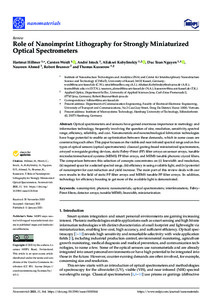Role of Nanoimprint Lithography for Strongly Miniaturized Optical Spectrometers
| dc.date.accessioned | 2021-02-11T13:55:15Z | |
| dc.date.available | 2021-02-11T13:55:15Z | |
| dc.date.issued | 2021-01-11 | |
| dc.identifier | doi:10.17170/kobra-202102113197 | |
| dc.identifier.uri | http://hdl.handle.net/123456789/12496 | |
| dc.description.sponsorship | Gefördert durch den Publikationsfonds der Universität Kassel | |
| dc.language.iso | eng | |
| dc.rights | Namensnennung 4.0 International | * |
| dc.rights.uri | http://creativecommons.org/licenses/by/4.0/ | * |
| dc.subject | nanoimprint | eng |
| dc.subject | photonic nanomaterials | eng |
| dc.subject | optical spectrometers | eng |
| dc.subject | interferometers | eng |
| dc.subject | Fabry– Pérot filters | eng |
| dc.subject | detector arrays | eng |
| dc.subject | tunable MEMS | eng |
| dc.subject | linewidth | eng |
| dc.subject | miniaturization | eng |
| dc.subject.ddc | 530 | |
| dc.title | Role of Nanoimprint Lithography for Strongly Miniaturized Optical Spectrometers | eng |
| dc.type | Aufsatz | |
| dcterms.abstract | Optical spectrometers and sensors have gained enormous gimportance in metrology and information technology, frequently involving the question of size, resolution, sensitivity, spectral range, efficiency, reliability, and cost. Nanomaterials and nanotechnological fabrication technologies have huge potential to enable an optimization between these demands, which in some cases are counteracting each other. This paper focuses on the visible and near infrared spectral range and on five types of optical sensors (optical spectrometers): classical grating-based miniaturized spectrometers, arrayed waveguide grating devices, static Fabry–Pérot (FP) filter arrays on sensor arrays, tunable microelectromechanical systems (MEMS) FP filter arrays, and MEMS tunable photonic crystal filters. The comparison between this selection of concepts concentrates on (i) linewidth and resolution, (ii) required space for a selected spectral range, (iii) efficiency in using available light, and (iv) potential of nanoimprint for cost reduction and yield increase. The main part of this review deals with our own results in the field of static FP filter arrays and MEMS tunable FP filter arrays. In addition, technology for efficiency boosting to get more of the available light is demonstrated. | eng |
| dcterms.accessRights | open access | |
| dcterms.creator | Hillmer, Hartmut | |
| dcterms.creator | Woidt, Carsten | |
| dcterms.creator | Istock, André | |
| dcterms.creator | Kobylinskiy, Aliaksei | |
| dcterms.creator | Nguyen, Duc Toan | |
| dcterms.creator | Ahmed, Naureen | |
| dcterms.creator | Brunner, Robert | |
| dcterms.creator | Kusserow, Thomas | |
| dc.relation.doi | doi:10.3390/nano11010164 | |
| dc.subject.swd | Optische Spektroskopie | ger |
| dc.subject.swd | Spektrometer | ger |
| dc.subject.swd | Nanophotonik | ger |
| dc.subject.swd | Lithografie | ger |
| dc.subject.swd | Linienbreite | ger |
| dc.type.version | publishedVersion | |
| dcterms.source.identifier | EISSN 2079-4991 | |
| dcterms.source.issue | Issue 1 | |
| dcterms.source.journal | Nanomaterials | ger |
| dcterms.source.pageinfo | 164 | |
| dcterms.source.volume | Volume 11 | |
| kup.iskup | false |
Dateien zu dieser Ressource
Das Dokument erscheint in:
-
Artikel [1169]


